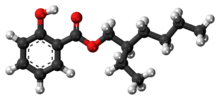Octyl salicylate
 | |
 | |
| Names | |
|---|---|
| IUPAC name
2-ethylhexyl 2-hydroxybenzoate | |
| Other names
octisalate; 2-ethylhexyl salicylate; ethyl hexyl salicylate; 2-ethylhexyl ester salicylic acid; salicylic acid, 2-ethylhexyl ester; benzoic acid, 2-hydroxy-, 2-ethylhexyl ester; 2-ethylhexyl ester benzoic acid, 2-hydroxy-; 2-hydroxy- 2-ethylhexyl ester benzoic acid; | |
| Identifiers | |
| 118-60-5 | |
| 3D model (Jmol) | Interactive image |
| ChEMBL | ChEMBL117388 |
| ChemSpider | 8061 |
| ECHA InfoCard | 100.003.877 |
| PubChem | 8364 |
| UNII | 4X49Y0596W |
| |
| |
| Properties | |
| C15H22O3 | |
| Molar mass | 250.33 g/mol |
| Density | 1.014 g/cm3 |
| Melting point | < 25 °C (77 °F; 298 K) |
| Boiling point | 189 °C (372 °F; 462 K) |
| Hazards | |
| NFPA 704 | |
| Except where otherwise noted, data are given for materials in their standard state (at 25 °C [77 °F], 100 kPa). | |
| | |
| Infobox references | |
Octyl salicylate, or 2-ethylhexyl salicylate, is an organic compound used as an ingredient in sunscreens and cosmetics to absorb UVB (ultraviolet) rays from the sun.[1] It is an ester formed by the condensation of a salicylic acid with 2-ethylhexanol. It is a colorless oily liquid with a slight floral odor.
The salicylate portion of the molecule absorbs ultraviolet light, protecting skin from the harmful effects of exposure to sunlight. The ethylhexanol portion is a fatty alcohol, adding emollient and oil-like (water resistant) properties.
Notes
References
- "Octisalate". EWG's Skin Deep. Retrieved 15 November 2011.
- "The Skin Cancer Foundation's Guide to Sunscreens". Skin Cancer Foundation. 2011. Retrieved 15 November 2011.
This article is issued from Wikipedia - version of the 4/7/2016. The text is available under the Creative Commons Attribution/Share Alike but additional terms may apply for the media files.
